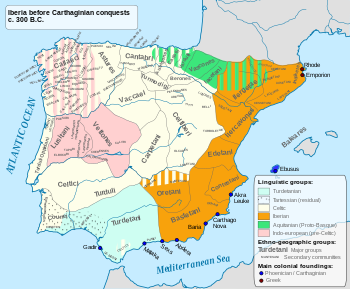
Back Astures AST Астури Bulgarian Astured Breton Àsturs Catalan Asturoj Esperanto Astures Spanish Astur (herria) Basque Astures French Ástures Galician Asturi IO

The Astures or Asturs, also named Astyrs,[1][2] were the Hispano-Celtic[3][4] inhabitants of the northwest area of Hispania that now comprises almost the entire modern autonomous community of the Principality of Asturias, the modern province of León, and the northern part of the modern province of Zamora (all in Spain), and eastern Trás os Montes in Portugal. They were a horse-riding highland cattle-raising people who lived in circular huts of stone drywall construction.[5] The Albiones were a major tribe from western Asturias.[6] Isidore of Seville[7] gave an etymology as coming from a river Astura, identified by David Magie as the Órbigo River in the plain of León, and by others as the modern Esla River.
- ^ Silius Italicus, Punica, III, 325.
- ^ Martino, Roma contra Cantabros y Astures – Nueva lectura de las fuentes (1982), p. 18, footnote 15.
- ^ Koch, John T. (2006). Celtic Culture: A Historical Encyclopedia. ABC-CLIO. p. 481. ISBN 9781851094400.
- ^ Cólera, Carlos Jordán (16 March 2007). "The Celts in the Iberian Peninsula:Celtiberian" (PDF). E-Keltoi. 6: 749–750. Archived from the original (PDF) on 24 June 2011. Retrieved 16 June 2010.
- ^ Mountain, Harry (1997). The Celtic Encyclopedia Volume I. uPublish.com. pp. 130, 131. ISBN 1-58112-890-8.
- ^ Koch, John (2005). Celtic Culture : A Historical Encyclopedia. ABL-CIO. pp. 789, 790. ISBN 978-1-85109-440-0.
- ^ Isidore of Seville, Etymologies, IX: 2, 112, noted by David Magie, "Augustus' War in Spain (26-25 B.C.)" Classical Philology 15.4 (October 1920:323–339) p.336 note 3.